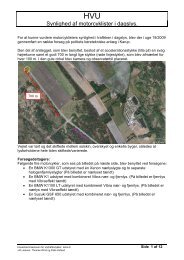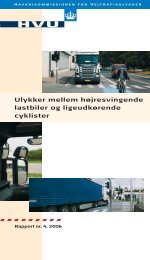Ulykker på motorveje - HVU
Ulykker på motorveje - HVU
Ulykker på motorveje - HVU
You also want an ePaper? Increase the reach of your titles
YUMPU automatically turns print PDFs into web optimized ePapers that Google loves.
56<br />
• Drivers’ knowledge and understanding of the interaction between speed,<br />
visibility and stopping distance should be improved through information.<br />
Poor concentration<br />
Poor concentration can be linked to risk blindness. Motorways are considered<br />
to be safe and drivers do not to expect to find objects on the road, such as<br />
shed loads. This, in many cases, results in poor driver concentration and<br />
response and reaction times to, for example, unexpected objects on the road<br />
that are too long. This can also mean that drivers choose a speed that is too<br />
high, because they do not expect to have to brake.<br />
The monotonous nature of motorway driving may at times contribute to poor<br />
driver concentration and higher reaction times to unexpected situations.<br />
Drivers may also not understand how far their vehicle travels in the period<br />
of time they look away from the road.<br />
• The relationship between monotonous, uncomplicated driving and poor<br />
concentration in motorway driving should be investigated further. Further<br />
research into the effect of distractions on motorway users’ concentration<br />
would be very relevant to this work.<br />
Speed<br />
Over 50% of drivers involved in accidents were exceeding the speed limit. In<br />
most cases, however, vehicle speeds were only marginally over the limit. Few<br />
drivers had speeds of over 130 kph. In two-thirds of the accidents studied,<br />
speed contributed to the accident occurring or the level of damage or injury.<br />
This applies not only to those driving very fast, but also to the two-thirds of<br />
drivers in the study whose speeds were between 110 kph and 130 kph.<br />
The analysis showed that there were two very different groups of drivers.<br />
Those driving at speeds that were too high for the poor weather or reduced<br />
visibility conditions and those driving at critical speeds in good weather. The<br />
first group were ordinary road users whose behaviour could be characterised<br />
as being relatively unexceptional. The second group of drivers are better<br />
characterised in terms of exhibiting high risk behaviour and poor road<br />
regulations compliance.<br />
• Information, campaigns and training aimed at road users should be targeted<br />
at correcting experienced road users’ incorrect evaluation of their own<br />
driving skills and at their poor understanding of how great a role speed<br />
plays in accidents.<br />
High-risk behaviour<br />
One in five accidents involved high-risk behaviour where the drivers had<br />
consciously challenged their own personal limits as well as those of the<br />
vehicle and had usually been driving at very high speeds or were driving<br />
under the influence of alcohol.<br />
Temarapport • ULYKKER PÅ MOTORVEJE





